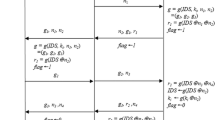Abstract
Here we propose a trajectory privacy model to solve privacy and security problems with radio-frequency identification (RFID) systems. The model first formalizes an Adversary Model and then defines an adversary indistinguishability privacy game and interval security privacy game according to the ability of the adversary. Based on the privacy game between adversary and challenger, the author gives the definition of weak trajectory privacy and strong trajectory privacy. Finally, we analyzed the privacy protection level of present RFID systems with the help of this trajectory privacy model. It can be seen that the trajectory privacy model can effectively analyze and find the privacy vulnerabilities of RFID security protocols.


Similar content being viewed by others
References
Vaudenay, S. (2007). On privacy models for RFID. In Proceedings of the advances in crypotology 13th international conference on theory and application of cryptology and information security (pp. 68–87). Berlin, Heidelberg: Springer.
Juels, A., & Weis, S. A. (2009). Defining strong privacy for RFID. ACM Transactions on Information and System Security, 13(1), 7.
Deng, R. H., Li, Y., Yung, M., et al. (2010). A new framework for RFID privacy. In Proceedings of the 15th European conference on research in computer security (pp. 1–18). Berlin, Heidelberg: Springer.
Liu, H., Yan, L., Chang, Y., Fang, H., & Zhang, T., (2013). Spectral deconvolution and feature extraction with robust adaptive Tikhonov regularization. IEEE Transactions on Instrumentation and Measurement, 62(2), 315–327.
Ha, J., Moon, S., Zhou, J., et al. (2008). A new formal proof model for RFID location privacy. In Proceedings of the 13th European symposium on research in computer security (pp. 267–281). Berlin, Heidelberg: Springer.
Hermans, J., Pashalidis, A., Vercauteren, F., et al. (2011). A new RFID privacy model. In: Proceedings of the 16th European symposium on research in computer security (pp. 568–587). Berlin, Heidelberg: Springer.
Yang, A., Zhuang, Y., Wong, D. S., et al. (2013). A new unpredictability-based RFID privacy model. In J. Lopez, X. Huang, & R. Sandhu (Eds.), Network and system security (pp. 479–492). Berlin, Heidelberg: Springer.
Liu, H., Zhang, Z., Liu, S., Liu, T., Yan, L., & Zhang, T. (2015). Richardson–Lucy blind deconvolution of spectroscopic data with wavelet regularization. Applied Optics, 54(7), 1770–1775.
Liu, H., Zhang, T., Yan, L., Fang, H., & Chang, Y. (2012). A MAP-based algorithm for spectroscopic semi-blind deconvolution. Analyst, 137(16), 3862–3873.
Ma, C., Li, Y., Deng, R. H., et al. (2009). RFID privacy: Relation between two notions, minimal condition, and efficient construction. In Proceedings of the 16th ACM conference on computer and communications security (pp. 54–65). ACM.
Moriyama, D., Matsuo, S., Ohkubo, M. (2012). Relations among notions of privacy for RFID authentication protocols. In Proceedings of the 17th European symposium on research in computer security (pp. 661–678). Berlin, Heidelberg: Springer.
Coisel, I., & Martin, T. (2013). Untangling RFID privacy models. Journal of Computer Networks and Communications, 2013, 1–26.
Paise, R. I., Vaudenay, S. (2008). Mutual authentication in RFID: Security and privacy. In Proceedings of the ACM symposium on information, computer and communications security (pp. 292–299). ACM.
Damgard, I., Pedersen, M. Q. (2008). RFID security: Tradeoffs between security and efficiency. In Proceedings of the IACR conferences and workshops on topics in cryptology (pp. 318–332). Berlin, Heidelberg: Springer.
Van Deursen, T., Mauw, S., Radomirovie, S. (2008). Untraceability of RFID protocols. In Proceedings of the information security theory and practices: Smart devices, convergence and next generation networks (pp. 1–15). Berlin, Heidelberg: Springer.
Alomair, B., Clark, A., Cuellar, J. et al. (2010). Scalable RFID systems: A privacy-preserving protocol with constant-time identification. In Proceedings of the 40th annual IEEE/IFIP international conference on dependable systems and networks (DSN’10) (pp. 1–10). Chicago.
Liu, H., Zhang, Z., Sun, J., & Liu, S. (2014). Blind spectral deconvolution algorithm for Raman spectrum with Poisson noise. Photonics Research, 2(6), 168–171.
Akgun, M., Caglayan, M. U. (2011). Extending an RFID security and privacy model by considering forward untraceability. In Proceedings of the 6th international workshop on security and trust management (pp. 239–254). Berlin, Heidelberg: Springer.
Liu, H., Zhang, Z., Shu, J., Liu, T., & Zhang, T. (2015). Multi-order blind deconvolution algorithm with adaptive Tikhonov regularization for infrared spectroscopic data. Infrared Physics and Technology, 71, 63–69.
Lai, J., Deng, R. H., Li, Y. (2010). Revisiting unpredictability-based RFID privacy models. In: Proceedings of the 8th international conference on applied cryptography and network security (pp. 475–492). Berlin, Heidelberg: Springer.
Liu, H., Liu, S., Zhang, Z., Sun, J., & Shu, J. (2014). Adaptive total variation-based spectral deconvolution with the split Bregman method. Applied Optics, 53(35), 8240–8248.
Acknowledgments
We thank the editor and reviewers for their valuable suggestions. This research was partially funded by the Self-determined Research Funds of CCNU from the Colleges’ basic Research and Operation of MOE (CCNU15A05009, CCNU15A05010), the National Social Science Fund of China (14BGL131), the Project of the Program for National Key Technology Research and Development Program (2013BAH18F02, 2015BAH33F02), Scientific R & D Project of State Education Ministry and China Mobile (MCM20121061).
Author information
Authors and Affiliations
Corresponding author
Rights and permissions
About this article
Cite this article
Zhang, W., Wu, L., Liu, S. et al. A Trajectory Privacy Model for Radio-Frequency Identification System. Wireless Pers Commun 90, 1121–1134 (2016). https://doi.org/10.1007/s11277-016-3381-y
Published:
Issue Date:
DOI: https://doi.org/10.1007/s11277-016-3381-y




